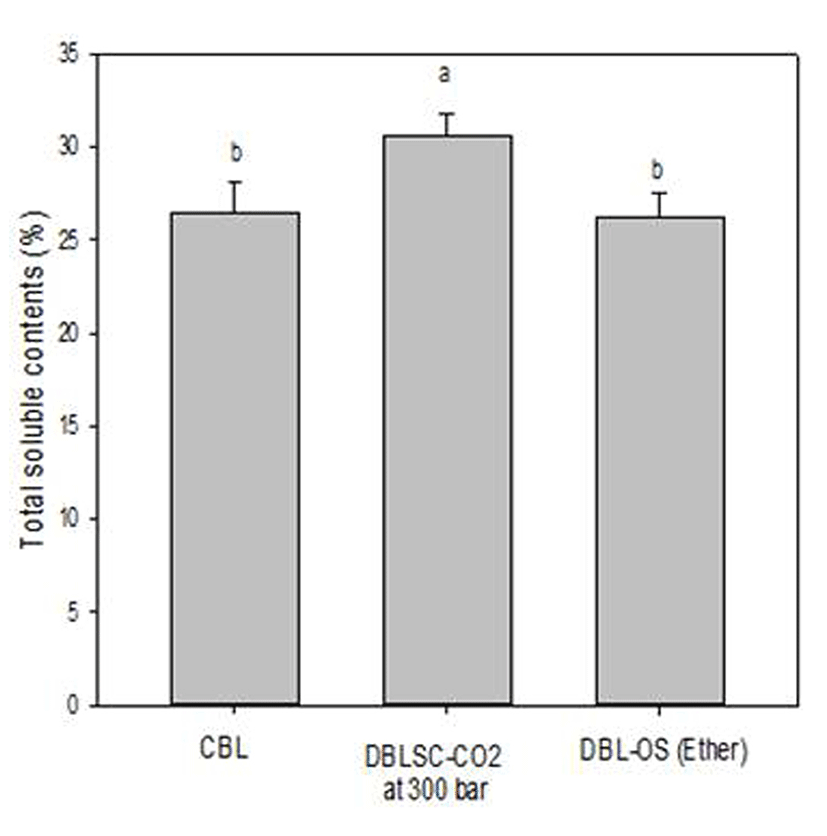Introduction
Bovine liver is a rich source of essential nutrients including proteins, minerals, and vitamins; it is approximately 1-2% of the live weight of the bovine (Li et al., 2014). It is a potential source of nutrients in relation to the safety and adequacy of human nutrition. Desiccated and defatted bovine liver may be a good source of high protein and low calorie food with vitamin A, B12, folate, iron, zinc, copper, and purine. Such foods can be used to prepare a healthy diet for children, the obese and anemic, nyctalopic, low immunity, and diabetic persons (Devatkal et al., 2004). Generally, bovine liver is underutilized in relation to its huge production across the world. This widely available bovine liver can be utilized for processing food formulations to support economically viable meat production systems (Estévez et al., 2005; Li et al., 2014).
A traditional organic solvent method is widely used for the extraction of lipid from plant and animal foods (Pariser et al., 1978). This method has several limitations such as loss of the nutrient content and functional properties of foods, expensive and time consuming, toxic, and potential to adversely affect human health and the environment (Hultin, 1994; Staby and Mollerup, 1993).
Supercritical fluid extraction (SFE) method is a promising alternative to conventional organic solvent methods. This method has superior extraction properties including high compressibility, liquid-like density, low viscosity, and high diffusivity (Lim et al., 2002). SFE has many advantages over traditional organic solvent methods such as a lower critical temperature and surface tension, better selectivity, and being nontoxic, nonflammable, inexpensive, and easily removable from the extracts. Removal of lipid from foods using SC-CO2 at low operating temperature minimizes the thermal degradation of proteins, antioxidants, and other nutritionally valuable components (Imison and Unthank, 2000; Kiran and Zhuang, 1997).
The purpose of this study was to investigate the major quality characteristics, such as proximate composition, amino acid profile, sodium dodecyl sulfate-polyacrylamide gel electrophoresis (SDS-PAGE) pattern, and functional properties of CBL, DBLSC-CO2, and DBL-OS.
Materials and Methods
Bovine liver was purchased from a local market in Jinju, Korea, and was stored at −80°C until used. Diethyl ether (purity 99.0%) and chloroform (purity 99.5%), were obtained from Daejung Chemicals & Metals Co., Ltd., Korea. Methanol and all other chemicals used in the study were analytical or HPLC grade.
Frozen bovine liver was freeze-dried for 72-96 h. It was ground and DIN-sieved to obtain fine powder samples. Samples were stored at 4°C until used for SC-CO2 and organic solvent extraction.
The SC-CO2 extraction was performed using a supercritical fluid apparatus supplied by Ilshin Autoclave Co. (Korea). A schematic of the SC-CO2 extraction process is shown in Fig. 1. Liquid CO2 contained in the siphoned cylinder was cooled to 4°C by the chiller. Bovine liver powder (300 g) was loaded into the extraction vessel, the top of which was tightly sealed. CO2 was pumped through the vessel at a flow rate of 50 g/min at a constant temperature of 45°C using pressures of 200, 300, and 450 bar to obtain different DSFSC-CO2 samples. After completion (3 h), the vessel was gradually depressurized. Extracted oil and defatted powder were collected in a poly pack and maintained at 4°C for analysis. Extraction yield (%) was calculated as the weight of extracted oil obtained from the samples.

Lipid extraction from 50 g bovine liver samples was performed in a soxhlet apparatus for 14-16 h using ether or a mixture of chloroform/methanol (CM; 2:1 v/v) as organic solvents. After extraction was complete, the sediment was desolventized using air drying under a fume hood until no organic solvent odor was discernible. The defatted samples were stored at 4°C until further analysis and the extraction yield (%) was calculated as the weight of extracted oil obtained from the samples.
The proximate compositions of CBL, DBLSC-CO2, and DBL-OS were estimated for their moisture, ash, lipid, carbohydrate, and protein (N×6.25) contents following the method of AOAC (2000).
To establish the SDS-PAGE pattern, a 10 mg bovine liver sample was placed into a tube containing 1 mL lysis buffer (RIPA buffer, Sigma Aldrich Co., USA), and then sonicated five times (2 s each time) in ice. After incubation, the sonicated samples were transferred to room temperature for 30 min and then centrifuged at 12,000 g for 10 min at 4°C. The supernatant was used for sodium dodecyl sulfate-polyacrylamide gel electrophoresis (SDS-PAGE) analysis, following the method of Laemmli (1970), using 5% (w/v) stacking gel and 10% (w/v) separating gel. The electrophoresis was performed using a Mini-PROTEAN Tetra Cell (Bio-rad Laboratories, USA) at a constant voltage of 70 V for 100 min, followed by 10 mA/plate. After electrophoresis, the PAGE gel was stained with 1% Coomassie staining solution (1.0 g Coomassie Brilliant Blue R-250, 300 mL methanol, 600 mL H2O, and 100 mL acetic acid) for 15 min and destained using the same solution without dye. Protein quantification was performed by the analysis of bands using a scanning densitometer (UMAX PowerLook 1100, Taiwan).
Amino acid analysis was conducted according to the method of Jeong and Shim (2004) with minor modifications. Bovine liver samples of 50 mg were placed in heat-proof screw cap tubes and dissolved in 5 mL of 6 N HCl. The tubes were then flowed with N2 gas for 1 min and sealed. The samples were incubated in a drying oven at 110°C for 24 h. After reaction was complete, the supernatant was filtered using a glass filter. To remove HCl, the supernatant was concentrated using a rotary evaporator and the sediment was dissolved in 3 mL of sodium citrate buffer (pH 2.2). Finally, the solution was passed through a 0.45-μm PTFE filter (Sigma-Aldrich, Korea) and then analyzed using an auto amino acid analyzer (Biochrom 30, Sweden).
Water absorption capacity (WAC) was determined following the method of Jyothirmayi et al. (2006) with minor modifications. Bovine liver samples of 1.0 g were placed into 50 mL polypropylene conical centrifuge tubes and dissolved in 10 mL water, and then vortexed thoroughly and heated at 60°C for 15 min in a water bath (BS-21, Jeio Tech, Korea). The slurry was centrifuged at 3,000 g for 15 min. After centrifugation the supernatant was removed, and the sediment was drained for 30 min. The per unit weight gain was reported as the WAC (g/g).
Oil absorption capacity (OAC) was measured following the method Jyothirmayi et al. (2006) with some modifications. Samples of 1.0 g were placed into 50 mL polypropylene conical centrifuge tubes and thoroughly mixed with 10 mL of refined soybean oil. This mixture was heated at 60°C, with shaking, in a water bath (BS-21; Jeio Tech, Korea) for 1 h. The solution was centrifuged at 3,000 g for 15 min, then the supernatant was removed, and the sediment was drained for 30 min at room temperature. OAC (g/g) was calculated as the per unit weight gain of the sample.
Solubility was determined using a modification of the method of Rodriguez et al. (2005). Bovine liver sample solutions (1%, w/v) were prepared using a magnetic stirrer at room temperature for 3 h. The solution was then heated to 75°C in a water bath (BS-21; Jeio Tech, Korea) with little shaking at 185 g for 1 h. After heating was complete, the solution was allowed to stand for 30 min at ambient temperature and then centrifuged at 4,000 g for 25 min. A 10 mL aliquot of the supernatant was placed in a pre-weighed Petri dish and oven-dried at 105°C for 3 h. The total soluble content (%) was calculated as follows:
Total soluble content (%) = [(weight of solids in 10 mL × 10) / (weight of sample)] × 100
Emulsifying activity (EA) and emulsion stability (ES) were determined following the method of Pedroche et al. (2004) with minor modifications. Bovine liver samples of 0.5 g were dispersed in 12.5 mL of deionized water at room temperature and 12.5 mL of refined soybean oil was added. This was then homogenized (D-500 homogenizer; Wiggen Hauser, Germany) at 10,000 g for 1 min. The emulsions were then centrifuged at 1,300 g for 5 min. The volume was recorded before and after centrifugation and EA was calculated as follows:
EA (%) = [(height of emulsified layer) / (height of contents of the tube)] × 100
ES was measured after re-centrifugation at 1,300 g for 5 min following heating in a water bath (BS-21; Jeio Tech, Korea) at 80°C for 30 min; it was calculated as follows:
ES (%) = [(height of remaining emulsion layer) / (height of original emulsified layer)] × 100
Foaming capacity (FC) and foaming stability (FS) were determined based on the method of Ogunwolu et al. (2009) with minor modifications. The solutions of bovine liver sample (1%, w/v) were prepared in a 50 mL polypropylene conical tube and then homogenized (D-500 Wiggen Hauser, Germany) at 20,000 g for 2 min. The foaming solutions were immediately transferred to a 100 mL graduated cylinder and the foam volume was recorded before and after homogenization. FC was expressed as the increase in volume (%) after homogenization. To obtain FS, the graduated cylinder was allowed to stand at room temperature, and the foam volume was recorded after 20, 40, 60, 80, and 100 min. FC and FS were calculated as follows:
FC (%) = [(volume after homogenization − volume before homogenization) / volume before homogenization] × 100
FS (%) = [(volume of foam after standing) / (initial foam volume)] × 100
All data are presented as mean values ± standard deviations (SD). The data were analyzed using SAS® program, (versions 9.1; SAS Institute Inc., USA) and analysis of variance was performed following the ANOVA procedures. Duncan’s multiple range test was used to determine the difference of means, with p<0.05 as the cut off for statistical significance.
Results and Discussion
The proximate composition is a fundamental analysis used to evaluate the essential nutrient content of food. The chemical composition of CBL, DBLSC-CO2, and DBL-OS is shown in Table 1. CBL was higher in fat content than DBLSC-CO2 and DBL-OS, whereas it was found that all DBLSC-CO2 samples had significantly higher (p<0.05) protein, carbohydrate, and fiber contents than CBL and DBL-OS. It was also observed that the protein, carbohydrate, and fiber contents among the DBLSC-CO2 samples prepared using different pressures were not significantly different (p>0.05). Sparks et al. (2006) reported similar results that the SC-CO2-defatted rice bran had higher protein and ash contents than rice bran defatted using hot organic solvent. Khorshid et al. (2007) postulated that maximum recovery of soy protein was achieved using a pressurized CO2 extraction process. Stahl et al. (1980) confirmed that defatting using SC-CO2 had no deleterious effects on the nutritional value of oil seeds. Pariser et al. (1978) demonstrated that protein denaturation is associated with conventional liquid solvents because of the removal of lipids.
1 All values are mean±SD (n=3). Different letters indicate that means are significantly different (p<0.05) by Duncan’s test.
Extraction yield (%) of lipid from CBL was calculated after extraction using the SC-CO2 and organic solvent methods. The amount of extracted lipid when using the SC-CO2 method was found to be significantly higher (p<0.05) than organic solvent method, and the yield increased in line with increasing operating pressure between 200 and 450 bar (Fig. 2). Sparks et al. (2006) reported similar results, i.e., a higher yield of rice bran oil was observed when using SC-CO2 than when using propane as the organic solvent. Herrero et al. (2006) demonstrated that SC-CO2 has better transport properties and offers faster extraction yields than liquids. Rubio-Rodriguez et al. (2012) postulated that SC-CO2 is effective in obtaining fish oil, including high amounts of ω-3 fatty acids. Thus, in the present study, lipid yields when using SC-CO2 were closely related to other reported results.
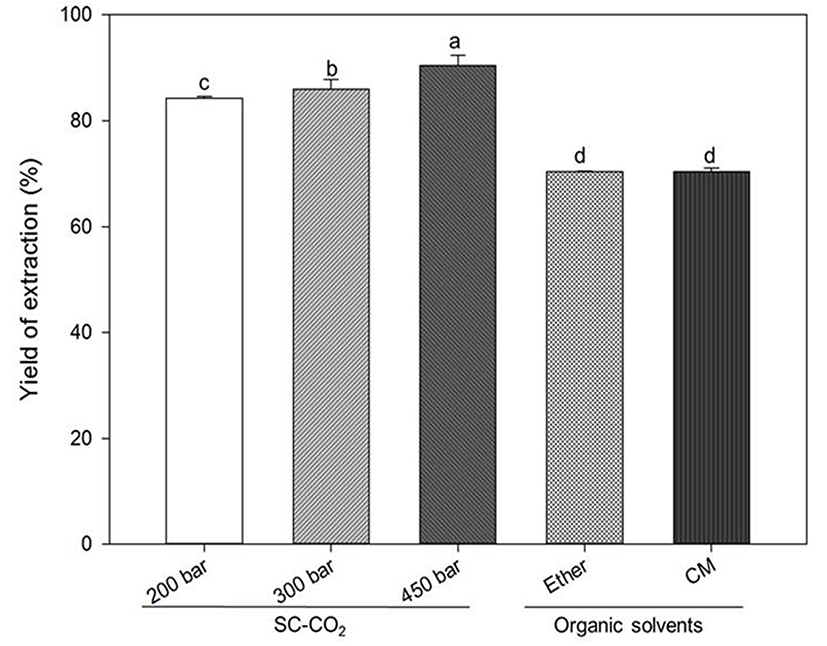
SDS-PAGE is the most commonly used analytical method for characterizing proteins in terms of molecular weight (Mw), peptide structure, purity, and distribution pattern. Under reducing conditions using 2-mercaptoethanol, the protein patterns of CBL, DBLSC-CO2, and DBL-OS were observed (Fig. 3). The staining intensity of the protein bands of the DBLSC-CO2 samples was shown to be similar to that of CBL (Fig. 3A; lane 2, and lanes 3, 4, and 5), whereas the DBL-OS samples appeared very poor or no bands intensity for proteins, particularly in the 50 to 75 kDa and 20 to 25 kDa Mw ranges (Fig. 3B; lanes 3 and 4). The protein content of an electrophoretic band depends on the area and intensity of the band. These parameters indicate that DBLSC-CO2 had no protein denaturation and had a similar protein content (including quality) to CBL. Similarly, Asaduzzaman and Chun (2015) demonstrated that the gel banding patterns of the protein of SC-CO2-treated mackerel residues were more prominent than those in n-hexane-treated samples. Uddin et al. (2009) and Abdelkarder et al. (2012) reported that no protein denaturation was found in SC-CO2-treated squid viscera and krill samples. Park et al. (2008) noted the similar intensity of the electrophoretic patterns of SC-CO2-treated and control mackerel viscera samples.
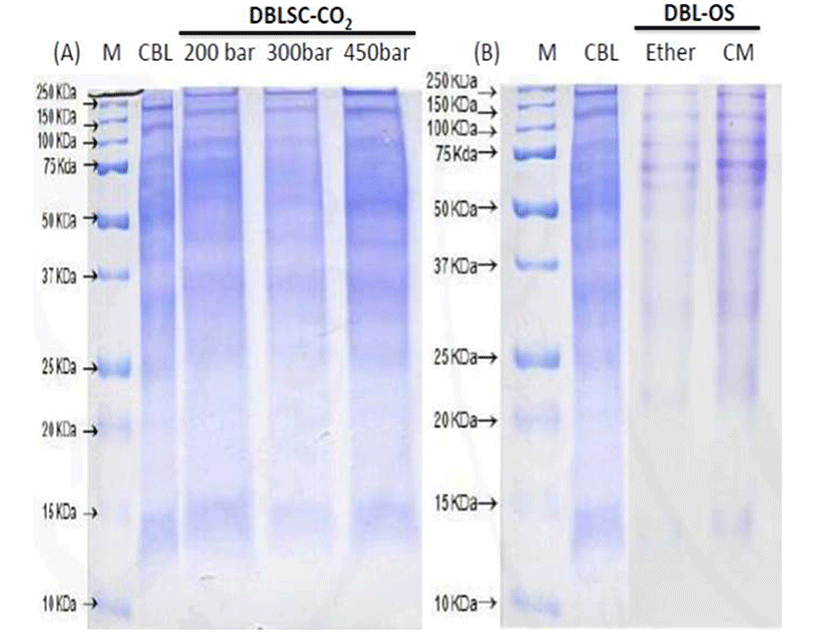
Amino acids are essential nutrients associated with the growth of infants and strengthen the immunity of the human body. The amino acid compositions of CBL, DBLSC-CO2, and DBL-OS are listed in Table 2. Seventeen amino acids were identified in freeze-dried bovine liver samples, including large amounts of essential and nonessential amino acids. In all samples, leucine had the highest content, followed by phenylalanine, lysine, arginine, and alanine. The contents of most amino acids in DBLSC-CO2 samples were significantly higher (p<0.05) than those in DBL-OS samples. Because of the minimization of amino acid denaturation in DBLSC-CO2, it appears to be a better source of amino acids than DBL-OS. Stahl et al. (1980) reported that the SC-CO2 method had no effect on the proteins of oilseed meal. Park et al. (2008) demonstrated that the activity of digestive enzyme proteins and the amino acid content of mackerel viscera were increased to a greater extent after the removal of oil when using SC-CO2 than when using organic solvent. Christianson et al. (1984) postulated that peroxidase activity in corn germ flour defatted using SC-CO2 was decreased to one-tenth than that of hexane-extracted flour.
1Chloroform/methanol (2:1, v/v).
2All values are mean±SD (n=3). Different letters indicate that means are significantly different (p<0.05) by Duncan’s test.
The functional properties of bovine liver were observed using samples of CBL, DBLSC-CO2 (at a pressure of 300 bar), and DBL-OS (ether).
Fluid retention is an index of the ability of proteins to absorb and retain water. Protein and carbohydrates are the major chemical components that support the WAC and OAC of food. In this study, DBLSC-CO2 (3.25 g/g) was found to give superior WAC over CBL (3.01 g/g) and DBL-OS (3.07 g/g), as shown in Fig. 4. Friedman (1996) postulated that the degree of protein denaturation was an important factor in terms of WAC. Siwaporn et al. (2008) demonstrated that a lipid content of flour limit the WAC. Chandi and Sogi (2007) noted that a WAC of 1.49 to 4.72 (g/g) was necessary for viscous foods such as soup. The OAC is another important functional property, influencing mouthfeel and flavor retention (Kinsella, 1976). Abdalbasit et al. (2010) reported that high oil absorption is essential, particularly for sausages, cake batters, mayonnaises, and salad dressings. It was found that DBLSC-CO2 (2.04 g/g) had a significantly higher (p<0.05) OAC than CBL (1.91 g/g) and DBL-OS (1.82 g/g), as shown in Fig. 4. Ogunwolu et al. (2009) demonstrated that the protein content of cashew nut and soy protein products influenced the OAC. Siwaporn et al. (2008) reported that defatted macadamia flour exhibited a greater OAC than control samples. Therefore, the higher WAC and OAC suggest that protein denaturation was minimized in DBLSC-CO2, thus producing a better quality defatted bovine liver than DBL-OS.
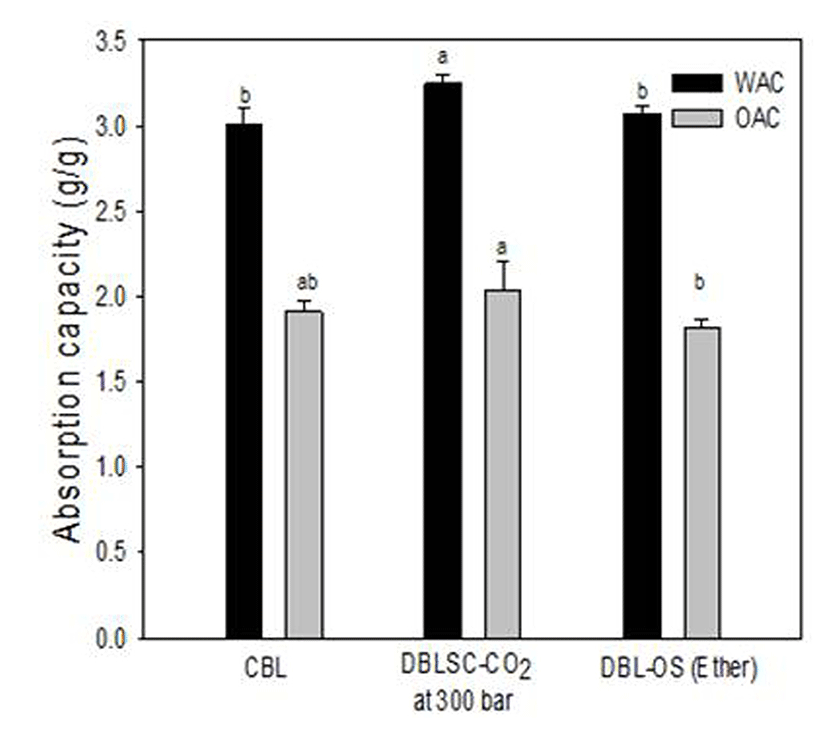
Solubility is the most superior functional property, affecting the functionality of most other food applications. Kinsella et al. (1976) reported that protein solubility widely influences the functionalities of the emulsification, foaming, and gelation properties. Konak et al. (2014) demonstrated that in alkaline conditions, the solubility of CO2-treated oat proteins was significantly greater than in acidic conditions. The current study was conducted under neutral conditions at 80°C for 30 min, and it was found that DBLSC-CO2 (30.59%) had significantly higher (p<0.05) soluble contents than CBL (26.44%) and DBL-OS (26.21%), as shown in Fig. 5. Similarly, Konak et al. (2014) demonstrated that SC-CO2-defatted oat flour had a greater soluble protein content than flours produced using other processing methods. Asaduzzaman and Chun (2015) reported higher protein contents in the water soluble extracts of SC-CO2 defatted mackerel residues than in samples extracted using hexane as the organic solvent. Adebowale et al. (2005) postulated that the better solubility of defatted flour proteins from the Mucuna species was an indicator that they had promising food applications.
Emulsifying property is an important functionality that depends on chemical composition, e.g., protein and polysaccharide contents. The emulsifying activity of DBLSC-CO2 (65.62%) was significantly higher (p<0.05) than DBL-OS (60.02%), but was not significantly different (p>0.05) from that of CBL (65.38%). In addition, it was observed that CBL (96.11%) and DBLSC-CO2 (95.64%) expressed similar ES values, which were significantly higher (p<0.05) than that of DBL-OS (91.50%), as shown in Fig. 6. Siwaporn et al. (2008) reported that there was no significant difference (p>0.05) between the emulsifying properties of totally defatted macadamia flour and those of partially defatted flour, and that the presence of fat had no effect on emulsifying properties. Sun et al. (2008) postulated that SC-CO2-defatted canola meal (65%) had significantly higher EC than hexane-extracted canola pressed meal (59%), and it was suggested that SC-CO2 extraction has potential as an emulsifier in food applications. Konak et al. (2014) reported that SC-CO2-extracted oat flour showed better emulsification properties than oat flour extracted using other methods. Choi et al. (2010) reported that the emulsion stability of meat batter indicates the water and fat retention capacity of meat protein, that determine the quality characteristics of meat products.
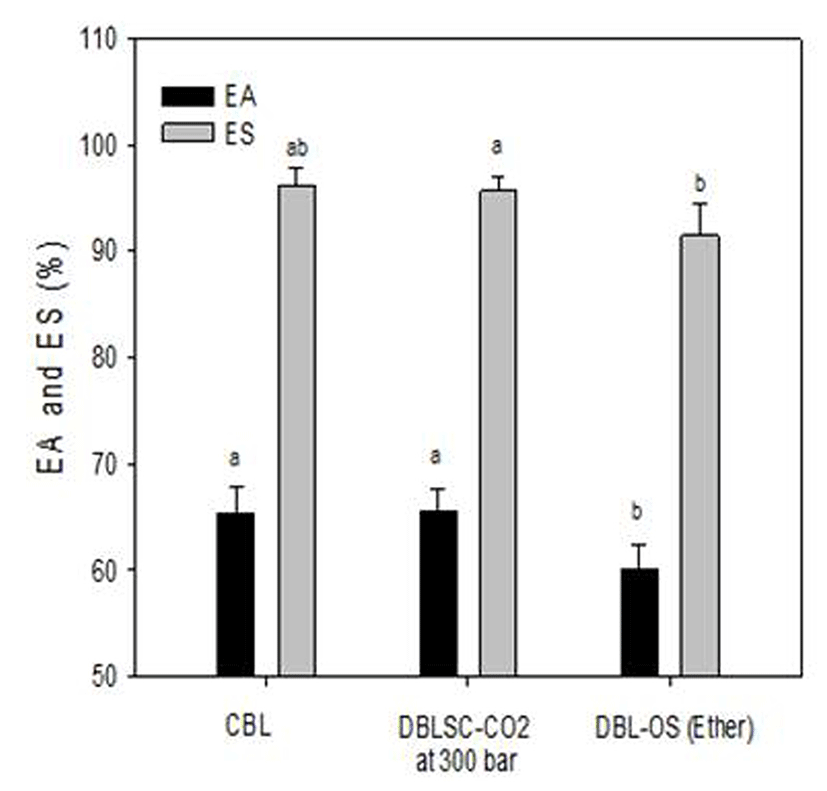
Foaming property is one of the major functionality in the food application of protein products. More soluble protein content in an aqueous phase enhances the formation of foam. In this study, the FC and FS of DBLSC-CO2 (55.94% and 69.42%, respectively) were significantly higher (p<0.05) than those of CBL (29.43% and 26.82%, respectively) and DBL-OS (44.86% and 46.46%, respectively) after homogenization, as shown in Fig. 7A. For CBL and DBL-OS samples, the reduction ratio of FS was found to be more significantly decreased over time than that of DBLSC-CO2 samples, as shown in Fig. 7B. Sun et al. (2008) demonstrated that the foam volume of SC-CO2-extracted canola meal was higher than that of samples extracted using hexane as the organic solvent. Konak et al. (2014) postulated that extracts from oat flour had a lower FC than samples extracted using CO2. Therefore, our study results confirm those of previously reported studies.
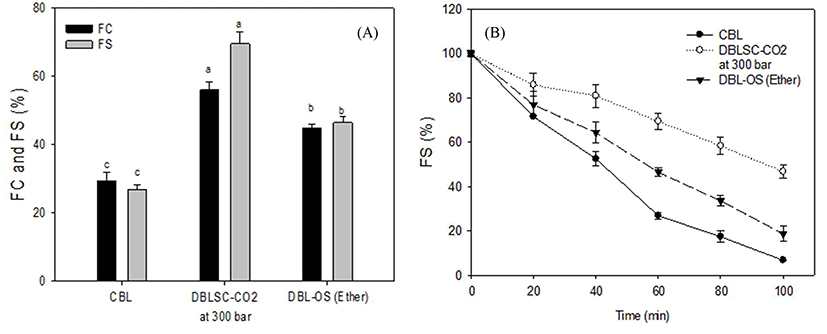
Conclusion
The present study has shown that DBLSC-CO2 is a potential source of essential nutrients and promising functionalities, making it an useful ingredient in food applications. However, it can be concluded that SC-CO2 offers a nutritionally and environmentally friendly approach to removing oil from high-protein food sources, and it is a better substitute for conventional organic solvent extraction.














